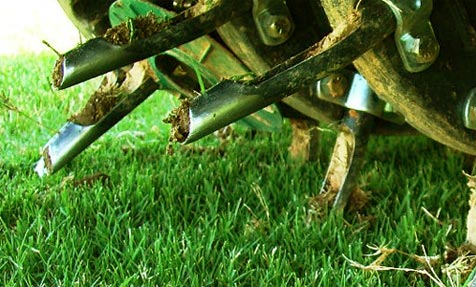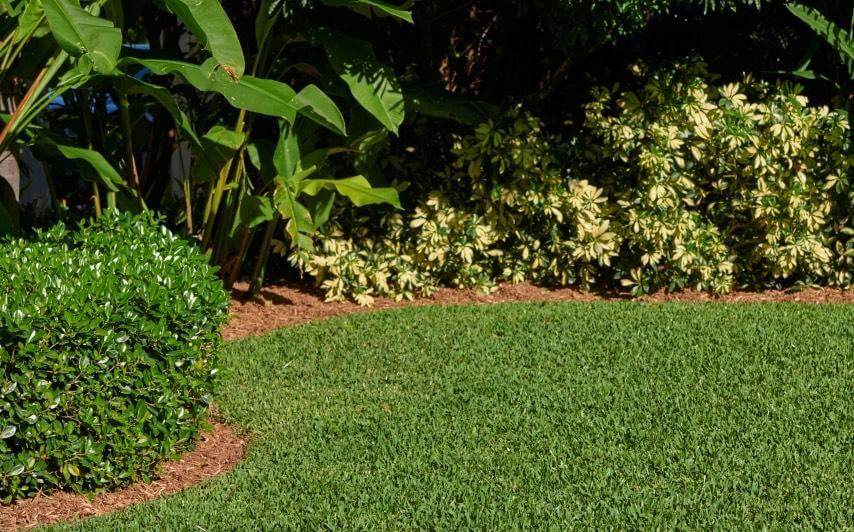To aerate St. Augustine grass, use a core aerator to remove small plugs of soil, creating channels for air, water, and nutrients to reach the roots. Aeration helps to alleviate soil compaction and promote healthy growth in the grass.
An essential aspect of maintaining a lush and vibrant St. Augustine grass lawn is proper aeration. By aerating, you can counteract the negative effects of soil compaction, such as limited water penetration and restricted root development. This essential lawn care practice involves creating small pathways in the soil, allowing air, water, and nutrients to reach the grass roots more easily.
We will guide you through the process of aerating St. Augustine grass, providing you with practical tips and guidance to ensure success in maintaining a healthy and thriving lawn.

Credit: cleancuts.net
What Is St Augustine Grass?
St Augustine grass, scientifically known as Stenotaphrum secundatum, is a warm-season grass variety commonly used in southern regions. It is highly popular due to its ability to thrive in hot and humid climates, making it an ideal choice for lawns in the southern United States.
Brief overview of St Augustine grass characteristics
St Augustine grass possesses several distinctive characteristics that set it apart from other grass varieties. Here are some key features of St Augustine grass:
| Traits | Descriptions |
|---|---|
| Dense Growth | St Augustine grass forms a dense turf with its vigorous lateral growth, making it resistant to weed invasion. |
| Shade Tolerance | This grass variety performs well in shaded areas, making it suitable for lawns with limited sunlight exposure. |
| Drought Tolerance | St Augustine grass has a moderate level of drought tolerance, allowing it to withstand periods of limited water availability. |
| Coarse Texture | The blades of St Augustine grass are wide, coarse, and have a blue-green color, providing a distinctive appearance to lawns. |
By understanding the unique attributes of St Augustine grass, you can effectively manage and maintain a healthy lawn using proper care techniques.
Understanding The Importance Of Aeration
Aerating St Augustine grass is a crucial step in maintaining a lush and healthy lawn. By understanding the importance of aeration, you can ensure that your grass thrives and looks its best.
Enhanced air circulation and oxygen flow: Aeration allows air to circulate more efficiently in the soil, delivering much-needed oxygen to the grassroots. This oxygen promotes strong and vigorous growth, resulting in a healthier and greener lawn.
Improved water penetration and nutrient absorption: Aeration helps water and nutrients penetrate deeper into the soil. This allows the roots to access essential moisture and essential nutrients, leading to improved overall health and resilience.
Reduction of thatch buildup: Thatch is a layer of organic matter that accumulates between the grass blades and the soil surface. Over time, excessive thatch can prevent water, air, and nutrients from reaching the roots. By aerating, you can alleviate thatch buildup and encourage a more efficient nutrient exchange.
Identifying Signs For Aeration
Identifying signs for aeration is crucial to maintaining a healthy St Augustine grass. Compact soil and excessive thatch can impede water and nutrient absorption, suffocating the grass roots. To tackle this issue, aerating the lawn will break up the compacted soil and alleviate thatch buildup, allowing the roots to breathe and flourish. Poor drainage and water runoff are strong indicators that aeration is necessary.
When water fails to penetrate the soil and drains away too quickly, it prevents essential nutrients from reaching the roots. As a result, the grass weakens and may develop bare patches. Weak grass growth and the presence of bare patches are also signs that aeration is required. By properly aerating your St Augustine grass, you can alleviate these problems and promote healthy growth throughout your lawn.
How to Aerate St Augustine Grass: Step by Step Guide
Suitable Time For Aeration
When it comes to aerating St Augustine grass, it is essential to determine the suitable time for the process. By considering seasonal factors and the grass’s growth patterns, you can ensure optimal results while avoiding stress on the grass during peak growth periods.
Aerating during the right season is crucial for the health and growth of St Augustine grass. The best time to aerate is typically during the spring or fall when the grass is in its active growth phase. During these periods, the grass can recover more quickly from the aeration process.
In addition to seasonal considerations, it is important to avoid aerating St Augustine grass during peak growth periods. Aerating during these times can cause stress to the grass and may result in damage. It is advisable to aerate when the grass growth is moderate, allowing the roots to expand and improve air and water circulation in the soil.
By carefully determining the optimal time for aeration, you can promote healthy growth and maintain the overall well-being of your St Augustine grass.
Pre-Aeration Preparation
To properly aerate St Augustine grass, there are necessary steps to take before starting the process. First, it is important to mow the grass to an appropriate height. This will ensure that the aerator can reach the soil effectively. Additionally, watering the lawn adequately is crucial before aerating. This will allow the soil to soften, making it easier for the aerator to penetrate the ground.
Adequate watering also helps prevent the risk of damaging the grass during aeration. By following these preparatory steps, you can ensure a successful aeration process for your St Augustine grass.
Choosing The Right Aeration Method
Choosing the right aeration method is crucial for maintaining a healthy St Augustine grass lawn. This grass variety requires proper aeration to promote strong root development and enhance its overall health.
One option for aerating St Augustine grass is core aeration with a machine. This method involves using a specialized machine to remove small plugs of soil, allowing for better air and water penetration into the root zone. Core aeration is particularly effective for compacted soil, improving its texture and reducing thatch buildup.
Another option is hand aerating with a garden fork or aerating shoes. This method is suitable for small areas or when you don’t have access to a core aerator. Simply push the fork or wear aerating shoes and make holes in the soil, providing space for air and water to reach the grass roots.
Both core aeration with a machine and hand aerating can significantly benefit St Augustine grass, creating an environment where it can thrive. However, it’s important to choose the method that suits your lawn’s needs and your available resources.
Aeration Techniques
Aerating St Augustine grass is an essential task to promote healthy growth and maintain a lush lawn. Here are the step-by-step techniques to aerate your lawn effectively:
- Choose the right time: It is recommended to aerate St Augustine grass during its active growth phase, typically in late spring or early summer.
- Prepare the lawn: Before aerating, mow the grass slightly shorter than usual and remove any debris or obstacles from the lawn.
- Use the correct equipment: Select a core aerator, which pulls plugs of soil from the ground, allowing water, nutrients, and air to reach the grassroots.
- Ensure proper spacing: Avoid overlapping holes and leave a gap of 3 to 4 inches between each plug to maximize the benefits of aeration.
- Methodically cover the lawn: Start aerating from one corner of the lawn and work your way across, overlapping each pass slightly to ensure complete coverage.
- Post-aeration care: After aerating, leave the soil plugs on the lawn to decompose naturally and water the lawn deeply to help the roots recover.
By following these techniques, you can effectively aerate your St Augustine grass, enhancing its overall health and ensuring a beautiful and thriving lawn.
Post-Aeration Care
|
After aerating your St Augustine grass, it is important to take essential measures for post-aeration care. One of the key steps is overseeding the lawn. This process involves spreading new grass seeds over the existing turf to fill in any bare spots and promote healthy growth. Additionally, applying fertilizer after aeration can provide the necessary nutrients for your grass to thrive. It is important to choose a fertilizer specifically formulated for St Augustine grass and follow the recommended application guidelines. Regular watering is another crucial step in post-aeration care. It is recommended to water the lawn deeply, allowing the water to penetrate the soil and reach the grassroots. This will help the newly aerated soil to settle properly and promote strong root development. Apart from overseeding and fertilizing, maintaining a regular watering and maintenance routine is essential. This includes mowing the grass at the appropriate height, removing weeds, and addressing any pest or disease issues promptly. |
Frequently Asked Questions Of How To Aerate St Augustine Grass
How Do You Aerate St Augustine Grass?
To aerate St Augustine grass, you can use a core aerator, which removes small plugs of soil. This helps loosen compacted soil and improve the flow of air, water, and nutrients to the roots. It is recommended to aerate in the spring or fall when the grass is actively growing.
Why Is Aeration Important For St Augustine Grass?
Aeration is important for St Augustine grass because it helps alleviate soil compaction. Compacted soil restricts the movement of air, water, and nutrients to the roots, leading to poor grass health. Aeration promotes root growth, enhances water penetration, and allows for better absorption of fertilizers and oxygen.
How Often Should You Aerate St Augustine Grass?
St Augustine grass should be aerated once or twice a year, depending on the soil conditions and foot traffic. If the soil is heavily compacted or the lawn receives heavy use, aerating once a year in the spring or fall is recommended.
Lighter soil or lower foot traffic may require aeration every 2-3 years.
Can You Over-Aerate St Augustine Grass?
Yes, it is possible to over-aerate St Augustine grass. Excessive aeration can damage the grass roots and disrupt the overall health of the lawn. Aerate only when necessary and avoid aerating during periods of stress, such as drought or extreme heat.
Proper timing and moderation are essential for effective aeration.
Conclusion
Aerating St Augustine grass is a crucial step in maintaining a healthy and vibrant lawn. By alleviating soil compaction and promoting better nutrient absorption, aeration allows the roots to penetrate deeper, resulting in stronger and more resilient grass. Whether you choose to use a manual or mechanical aerator, regular aerating practices will ultimately enhance the overall health and appearance of your St.
Augustine grass. So, get out there and give your lawn the love it deserves!

